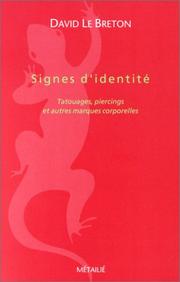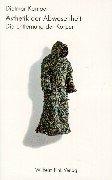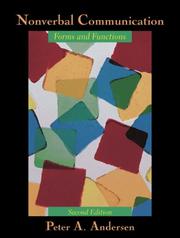| Listing 1 - 10 of 400 | << page >> |
Sort by
|

ISBN: 9782864244264 2864244268 Year: 2008 Publisher: Paris: Métailié,
Abstract | Keywords | Export | Availability | Bookmark
 Loading...
Loading...Choose an application
- Reference Manager
- EndNote
- RefWorks (Direct export to RefWorks)
L'industrie du design corporel s'épanouit. Le corps est devenu la prothèse d'un moi éternellement en quête d'une incarnation pour sursignifier sa présence au monde, pour adhérer à soi. Tatouage et piercing sortis de la marginalité sont devenus les accessoires de la mise en scène de soi. Partant du constat que le " corps marqué " a, depuis l'Antiquité et dans les sociétés traditionnelles, été l'expression d'un parcours d'un message et surtout d'une identité, David Le Breton montre comment l’Église s'est fortement opposée à cette pratique, mais aussi comment, après les marins et les soldats, la justice s'en est emparée comme d'une " marque infamante ". Il étudie la façon dont le tatouage intervient comme langage de révolte jusqu'à aujourd'hui où le piercing est bel et bien une identité à fleur de peau qui concerne la jeunesse. David Le Breton s'appuie sur une recherche de terrain pour analyser successivement : les marques corporelles dans les sociétés occidentales, le passage de la dissidence à l'affirmation de soi, la recherche d'une identité, les rites de passage, la naissance d'une culture. Il s'intéresse à la différence entre souffrance, douleur et plaisir sexuel qui restent liés à l'acte même du piercing. Il note enfin ce paradoxe selon lequel, si ce système de marquage corporel régresse fortement dans les sociétés traditionnelles, il se développe de façon rapide et inventive dans le monde occidental nanti, et il s'interroge sur notre désir individualiste de vouloir modifier notre corps. Extrêmement documenté, son livre fait le tour de la question, tant historique qu'anthropologique et philosophique, sur une mode nouvelle et en pleine expansion.
Body marking --- Tattooing --- Body piercing --- Body marking. --- Tattooing. --- Body piercing.
Book
ISBN: 9782070616381 207061638X Year: 2008 Publisher: [Paris] Gallimard Jeunesse
Abstract | Keywords | Export | Availability | Bookmark
 Loading...
Loading...Choose an application
- Reference Manager
- EndNote
- RefWorks (Direct export to RefWorks)
Le corps et ses multiples fonctions expliqués aux tout-petits à travers des transparents permettant d'observer l'envers des choses.
Book
ISBN: 1608826163 1608826171 9781608826162 9781572245464 1572245468 9781608826179 Year: 2008 Publisher: Oakland, CA New Harbinger Publications
Abstract | Keywords | Export | Availability | Bookmark
 Loading...
Loading...Choose an application
- Reference Manager
- EndNote
- RefWorks (Direct export to RefWorks)
Based on author Thomas Cash's clinically tested program, this major revision of The Body Image Workbook offers you who are concerned or distressed about their body image an eight-step program for transforming their relationships with their bodies.
Body image. --- Body image --- Self-acceptance.
Book
ISBN: 9780823229611 9780823229628 0823229610 0823229629 Year: 2008 Publisher: New York Fordham university press
Abstract | Keywords | Export | Availability | Bookmark
 Loading...
Loading...Choose an application
- Reference Manager
- EndNote
- RefWorks (Direct export to RefWorks)

ISBN: 3770534174 9783770534173 Year: 2008 Publisher: München : Fink,
Abstract | Keywords | Export | Availability | Bookmark
 Loading...
Loading...Choose an application
- Reference Manager
- EndNote
- RefWorks (Direct export to RefWorks)

ISBN: 9781577665434 1577995430 Year: 2008 Publisher: Long Grove (Ill.) : Waveland Press, Inc.,
Abstract | Keywords | Export | Availability | Bookmark
 Loading...
Loading...Choose an application
- Reference Manager
- EndNote
- RefWorks (Direct export to RefWorks)
Book
ISBN: 1281971766 9786611971762 9087904312 Year: 2008 Publisher: Rotterdam, Netherlands ; Taipei ; New York : Sense Publishers,
Abstract | Keywords | Export | Availability | Bookmark
 Loading...
Loading...Choose an application
- Reference Manager
- EndNote
- RefWorks (Direct export to RefWorks)
This book raises questions around pedagogy and illness. Morris explores two large issues that run through the text. What does the ill body teach? What does the teacher do through the ill body? The body has something to teach while teaching through the ill body. This book is theoretically framed by connections between spirituality and aesthetics. As the great spiritual traditions teach, our responsibility as teachers is to help others, especially those who are marginalized. What is lacking in our educational discourse is a discussion of the responsibility we all have to help those who get sick and not marginalize them. More specifically, pedagogical and curricular questions are fleshed out through working in the area of curriculum studies, depth psychology and the medical humanities. These three disciplines have something in common: autobiography. But in the field of curriculum studies autobiographies/ pathographies of sickness are few and far between. This book is meant to fill that gap in the educational literature. This pathography is a study that explores the mysteries of suffering, storytelling, memory, and poesis. Compassion, woundedness, vulnerability, testimony and authenticity are all issues Morris raises here. Teachers, scholars, depth psychologists and medical educators might be particularly interested in this intensely felt narrative about what it is like for teachers to teach while suffering from chronic illness.
Book
ISBN: 9789812813794 Year: 2008 Publisher: New Jersey World scientific
Abstract | Keywords | Export | Availability | Bookmark
 Loading...
Loading...Choose an application
- Reference Manager
- EndNote
- RefWorks (Direct export to RefWorks)
Book
Year: 2008 Publisher: [Washington, D.C.] : [Veterans Administration],
Abstract | Keywords | Export | Availability | Bookmark
 Loading...
Loading...Choose an application
- Reference Manager
- EndNote
- RefWorks (Direct export to RefWorks)
Book
ISBN: 9789048402892 Year: 2008 Publisher: Zoetermeer Free Musketeers
Abstract | Keywords | Export | Availability | Bookmark
 Loading...
Loading...Choose an application
- Reference Manager
- EndNote
- RefWorks (Direct export to RefWorks)
Mind and body --- Holism
| Listing 1 - 10 of 400 | << page >> |
Sort by
|

 Search
Search Feedback
Feedback About UniCat
About UniCat  Help
Help News
News